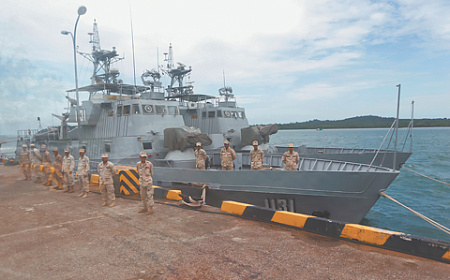
At a time when the United States has shaken up global stock markets with its tariffs, China presents itself as a bulwark of reliability and stability. This thesis was a common thread during Chinese President Xi Jinping’s tour of three Southeast Asian countries: Vietnam, Malaysia and Cambodia. Cambodia, the final stage of the trip, has actually become an ally of China in its confrontation with America. Beijing helped her build a naval base. Next up is the construction of a canal with a length of more than 150 km, which will become a highway facilitating the export of Chinese goods, as well as provide jobs for Cambodians.
Cambodia and China have signed an agreement to build a waterway that will connect a tributary of the Mekong River near Phnom Penh, Cambodia’s capital, with a port in the Gulf of Thailand. According to the AP news agency, the price of this ambitious project is $ 1.2 billion.
Cambodian Prime Minister Hun Manet has previously stated that the canal will be built, no matter how much it costs. After all, this is a project that embodies the prestige of the country in the international arena, its territorial integrity and success in development. However, these pretentious words do not reflect reality. In fact, the terms of the deal show that Cambodia itself is not able to create a channel. The construction will become a joint venture, where the Cambodian side owns 51% and the Chinese 49%.
As follows from the official statement in Phnom Penh, thanks to the canal, a river–sea corridor will be laid overland, along which vessels with a carrying capacity of 3 thousand tons will be able to sail. The project includes the process of digging the canal, the construction of berths, as well as navigation and logistics infrastructure. On the Chinese side, the contractor company is part of the China Communications Construction Company, a state-owned corporation. Wang Tongzhou, chairman of this company, said that the canal will serve as an accelerator for the growth of Cambodia’s economy and help its industry. Thanks to this project, Cambodia will be able to create up to 50,000 jobs.
This is the side of the coin that Beijing and its firm tirelessly promote in the media. But there is another side of the coin that Beijing is silent about. The aforementioned firm has been involved in financial scandals. The United States has added this company to its blacklist due to the fact that it is involved in the creation of new artificial islands in the South China Sea. And these islands are used by the People’s Liberation Army of China.
Beijing’s opponents also say that the construction will deal a powerful blow to the environment. The natural mechanism of ebb and flow on the Mekong will be disrupted. And this, in turn, will lead to more frequent droughts, reducing the layer of fertile substances that the current of the Mekong brings to its shores. This is fraught with particularly serious consequences for Vietnam. After all, Vietnam is the main supplier of rice in the region, and the nutritional level of millions of people depends on it.
But Beijing and Phnom Penh said the environmental impact of the construction site had been thoroughly analyzed. 48 experts concluded that there would be no harmful consequences. The Cambodian authorities have acknowledged that some of the settlements along the banks of the Mekong River will have to be relocated. But the needs of the displaced will be taken into account.
Xi Jinping visited Cambodia for the first time since 2016. Hun Manet called the guest an important and irreplaceable friend who helps Cambodia’s economic and social progress. Even one of the avenues in Phnom Penh was named after Xi.
The Chinese leader was met at the airport by King Norodom Sihamoni. Cambodia, according to Xi, occupies a priority place in China’s foreign policy. In Phnom Penh, he sought to bring to the attention not only of his interlocutors, but also of the Asian public that China, unlike the United States, is a reliable, solid trading partner that does not impose tariffs that undermine established supply chains on different continents.
Cambodia will face intense pressure from the United States. After all, when the 90-day pause on the new tariffs ends, Cambodia will face an additional 49% duty on its exports to America in addition to the previous 10%.
Astrid Norid Nilson, a senior lecturer at Lund University in Sweden, says: “Xi Jinping toured Southeast Asia wearing the armor of a leader with moral authority, a friendly leader who can be relied upon.”
But diplomacy alone is not enough for Beijing to ensure its interests in the region. He is seeking to ensure that the Chinese Navy, which has established its control over most of the South China Sea, has a foothold in Cambodia. The naval base of Ream became such a point. Its construction was carried out mainly at the expense of China. The construction was completed a couple of weeks before Xi’s visit.
Thus, Beijing has fulfilled its strategic task in this country. However, the Cambodian government says that the base is not only intended for Chinese, but is open to all. Two Japanese destroyers will be the first military visitors to this port. But this gesture towards Tokyo does not change the essence of the matter. Cambodia has remained within the Chinese sphere of influence for many years.
